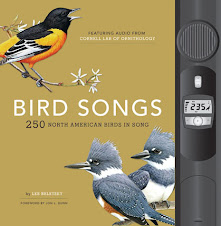They usually lay 3 to 5 eggs. The mama sits on them for 12 to 14 days. Mother purple finch and the father purple finch both feed the chicks. The chicks eat regurgitated seeds.
The nests are built by the female purple finch. The nests are made of sticks, grasses, and leaves. They are in a small cup shape and they have deer fur, snowshoe hair or rabbit fur in them.
The males are the color of a raspberry fruit drink. Their head feathers can stick up straight. The females are brown with no red. The young look like the female.
 The female is on the left, and the male is on the right. We also see an American Goldfinch in this picture!
The female is on the left, and the male is on the right. We also see an American Goldfinch in this picture!The call can be found on this web page.






